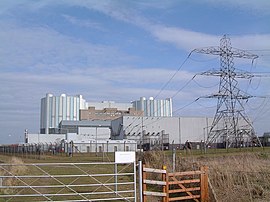Oldbury nuclear power station
| Oldbury Nuclear Power Station | |
|---|---|
 |
|
| Country | England, United Kingdom |
| Location | South Gloucestershire |
| Coordinates | 51°38′56″N 2°34′15″W / 51.648889°N 2.570833°WCoordinates: 51°38′56″N 2°34′15″W / 51.648889°N 2.570833°W |
| Status | Closed |
| Commission date | 1967 |
| Decommission date | 2012 |
| Owner(s) | Nuclear Decommissioning Authority |
| Operator(s) | Magnox Limited |
| Nuclear power station | |
| Reactor type | Magnox gas cooled |
| Reactor supplier | The Nuclear Power Group |
| Power generation | |
| Make and model |
Associated Electrical Industries C. A. Parsons and Company |
| Units decommissioned | 2 X 217 MW |
| Nameplate capacity | 434 MW 626 MW (Planned) |
Oldbury nuclear power station is a closed nuclear power station located on the south bank of the River Severn close to the village of Oldbury-on-Severn in South Gloucestershire, England. It was operated by Magnox Limited on behalf of the Nuclear Decommissioning Authority (NDA). Oldbury is one of four stations located close to the mouth of the River Severn and the Bristol Channel, the others being Berkeley, Hinkley Point A, and Hinkley Point B.
Opened in 1967, it had two Magnox reactors producing 424 megawatts (MWe) in total – enough electricity on a typical day to serve an urban area twice the size of Bristol. Reactor 1 went critical on 18 September 1967 and first generated electricity on 9 November 1967, Reactor 2 started generating electricity in April 1968.
The construction was undertaken by a consortium known as The Nuclear Power Group ('TNPG'). The reactors were supplied by TNPG and the turbines by AEI and C. A. Parsons & Co. The main civil engineering contractor was Sir Robert McAlpine. Construction on site began in 1961.
Oldbury was the first nuclear power station in the UK to use prestressed concrete pressure vessels, earlier Magnox reactors having used steel pressure vessels more suited to smaller reactors.
The design net power output of the station was 626 MWe, but due to steel corrosion problems from the hot carbon dioxide coolant within the reactor, operating temperature had to be reduced soon after operation started causing a large drop in power output. Initially power output was set at 424 MWe, dropping to 400MWe by 1973. Then as remedial measures were adopted power was progressively increased to 434 MWe by 1983 with a gas outlet temperature of 365 °C (689 °F), compared to the 412 °C (774 °F) design temperature, which was maintained as the normal operational output.
...
Wikipedia

